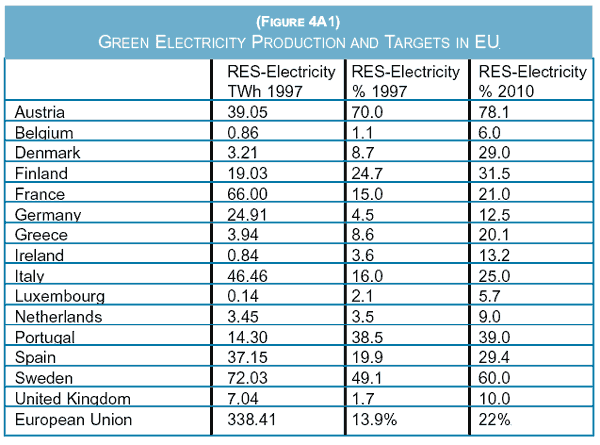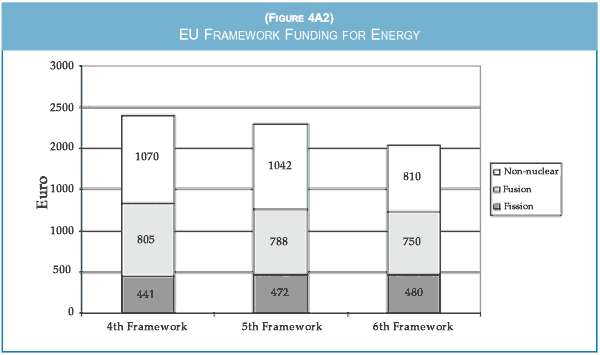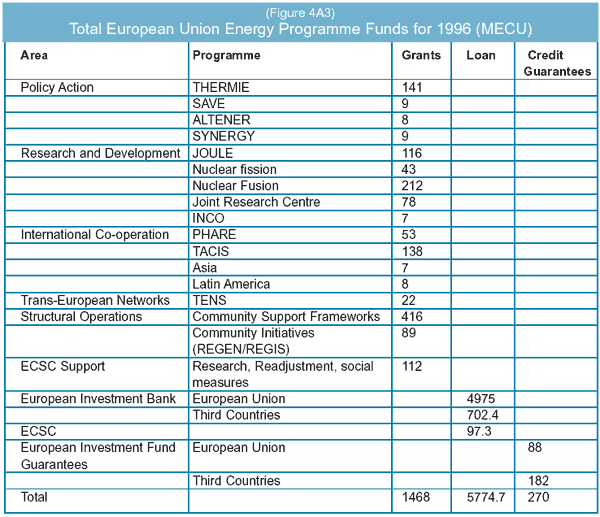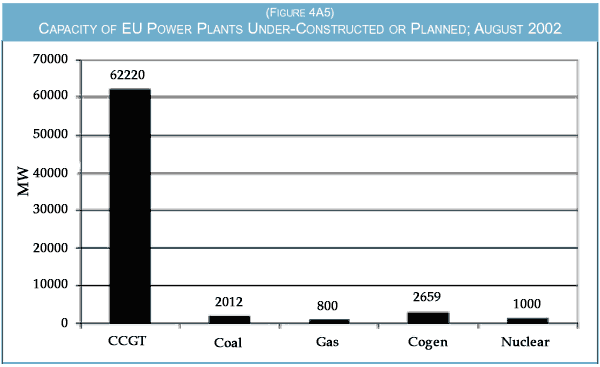The European Union's support for renewable energy
by Nuala Ahern ,Green Party MEP for Leinster
Although the EU has promoted renewable energy sources, it has failed
so far to ensure that energy markets take into account the cost of the
environmental damage caused by the use of fossil fuels and nuclear
energy. Renewables would be fully competitive if this was done.
The European Union doesn't have a single
energy policy, but rather a series of communications,
white and green papers and directives
which when patched together form a less-than-coherent
series of policy measures in the energy
field. This is somewhat ironic as the EU was
largely formed out of the desire by countries to
support their energy industries. Of the three
founding treaties of the EU, two related to supporting
energy industries. In 1952, the
European Coal and Steel Community agreement
was signed to support the development of
these two industries for fifty years - and in July
2002 ceased to exist. In 1957 the treaty establishing
the European Atomic Energy
Community (Euratom) was signed, which will
run indefinitely, explicitly promoting nuclear
technology.
Following the 1997 Amsterdam Treaty that
established the requirement for Community
policy to 'contribute to sustainable development'
the EU's energy policy is said to be based
on three core objectives. These are:1
- Security of supply. This aims to minimise the
risks and impacts of possible supply disruptions
on the EU economy and society.
- Competitive energy systems - to ensure low
cost energy for producers and consumers to
contribute to industrial competitiveness and
wider social policy objectives.
- Environmental protection. This is integrated
in both energy production and energy use to
maintain ecological and geophysical balances
in nature.
Let's look at the way renewables are treated in
relation to each of these core objectives.
1. SECURITY OF SUPPLY
In November 2000 the Commission published
its Green Paper on Security of Supply2. A public
consultation process followed its release and
lasted until February 2002. The Commission
was initially expected to prepare a white paper
or a directive based on the original documentation
and the comments received but in mid-
September 2002 it published two new directives
designed to reduce the insecurities for energy
supplies in the oil and gas industries.3 The purpose
of these directives is to propose specific
measures in the framework of a liberalised
energy market, particularly by increasing the
quantity of fuel mandated to be kept in stocks.
In the case of oil this will increase from 90 to
120 days, for natural gas to set a new requirement
of 60 days supply for an average bad
weather period.
The November 2000 Green Paper states clearly
that renewable energy has a vital role to play in
reducing the EU's dependency on third countries
for their energy. It says:
With regard to supply, priority must be given to
the fight against global warming. The development of new and renewable energies (including
biofuels) is the key to change.4 Only technology-intensive
renewable sources can help mitigate
the present trend towards increasing energy
dependency. 5
Despite this, the Green Paper merely calls for
member states to give a 'firm commitment'6 to
achieve the 'realistic' objectives of the 1997
White Paper on Renewable Energies. It is
important to note that the Green Paper was published
before a final decision was taken on the
2001 Directive on Renewable Energy and thus
undermined attempts to have the White Paper
targets made mandatory. At the request of the
Council, but clearly with the support of the
Commission and against the desires of the
Parliament, the White Paper targets were not
mandatory in the Directive on Renewable
Energy. So, while the Green Paper points out
renewables are fundamental for the future energy
supply of the Union, it fails to call for these
targets to be mandatory.
2. COMPETITION
In January 2003 the Council came to a
Common Position for the two security of supply
directives. The European Parliament has
begun discussions on these and is expected to
conclude its work in May 2003.
When the draft directives were read for the first
time in the Parliament, the Green/EFA group
made a number of key recommendations. These
were intended to accelerate the introduction of
renewables by creating a level playing field for
generators. The key recommendations were:
- Priority access for renewables: The current
Directive on renewable energy states that priority
access may be given to electricity produced
by renewable energy sources. This must be
changed to require priority access for renewables.
- Electricity Labelling: Companies should be
required to include information about the mix
of fuels they use to produce the electricity they
sell and the environmental impact of these fuels
on their advertising and all bills to their customers.
- Planning Applications: Smaller power plants
should not be subject to the same planning
applications as much larger stations. The environmental
impact, actual and potential, of a
1000 MW nuclear power stations is clearly
larger than the installation of a handful of wind
turbines. The Group therefore proposed that
generators under 50 MW should have access to
an accelerated planning process.
- Grid Pricing: Because there is excess generating
capacity in the EU, long-established conventional
generators often see renewables and
cogeneration projects as being in competition
with their existing or planned production.
These generators often influence grid companies
with whom they may be linked financially
to discriminate against the new players. For
example in France even producers of low voltage
electricity which is not passed through the
grid at all have to pay a standard fee as if it were.
The Group's rapporteur therefore proposed that
all financial links between grid operators and
generators should be prohibited, that statutory
regulators should have greater powers to set
prices for the use of the grid and that grid system
operators should be required to take
account of the economic advantages of embedded
generators.
Many of these proposals were accepted by the
Parliament but we now have to wait and see the
extent to which the Council will adopt them
too. However, even at this stage it is clear that
most of the Parliament's language will be
dropped or significantly watered down.
3. ENVIRONMENTAL PROTECTION.
In 2001 the Community finally adopted the
Electricity Production from Renewable Energy
Sources (RES) Directive. The primary justification
for the directive is the need to promote
renewable energy sources as a priority measure
given that their exploitation contributes to environmental
protection and sustainable development.
However, rather than the mandatory targets
requested by the Parliament and NGOs, the
directive only has indicative targets of 12% of
energy to be produced by renewable sources by
2010 -including a target of 22% of electricity.
These targets translate into the indicative
national requirements shown in figure 4A1,
which were determined by the present level of
renewable energy sources within each country's
current energy mix.
 |
| Ireland's below-average target for Energy Electricity from Renewable Sources (RES) |
Besides the lack of binding targets, critics point
to the inclusion of incineration of wastes as a
renewable energy source as a major loophole
and an environmental problem in the directive.
Member states have to transpose the directive
into national legislation during 2003.
ENERGY FUNDING
The major mechanism for EU funded research
and development is through the Framework
programme. Figure 4A2 shows that nuclear, fission
and fusion, research has remained relatively
constant in recent programmes, while conventional
energy has seen a decline of 20%. As
a result, nuclear technology receives 50% more
research funding that all other energy sources
combined.
 | | The shrinking amount of funds for non-nuclear energy research |
The €810 million provided for non-nuclear
research in the 6th Framework Programme covers:
- In the short and medium term:
- The main new and renewable energy sources
and their connection into the grid system
- Alternative motor fuels
- Energy saving and energy efficiency, particularly
in buildings
- For the medium and longer term:
- Fuel cells including applications for transport
and for stationary use
- Technologies for hydrogen as an energy carrier
and storage system
- New and advanced concepts for photovoltaic
energy and the advanced use of biomass
- Disposal of the CO2 produced by fossil fuel
plants.
The framework programme is not the only
mechanism for EU financial support for energy
research. The figure 4A3 below is a snapshot of
funding in 1996 for energy research.

From this
it is clear to see how little funding renewables
actually get in relation to all other programmes.
The only line dedicated to the development of
renewable energy is the Altener programme,
while the Synergy, Joule and JRC have also cofunded
some research. Furthermore, Phare and
Tacis programmes have also funded some
research into renewables, but only as a small
percentage of their total work, with most once
again going to nuclear technology.
ONGOING SUBSIDIES FOR THE NUCLEAR
INDUSTRY
Despite the European Commission and Council
both stating that they want to create a level
playing field in the energy sector, nuclear
power continues to get significant state subsidies
that distort the electricity market. Apart
from tax exemptions on the cost of nuclear fuel,
these are in two main areas:
- Nuclear liability:
Operators of nuclear
plants have their maximum liability for the
damage done by nuclear accidents limited
under the Paris and Vienna Conventions. In
some cases the nuclear facilities are insured for
more than the operator would ever have to pay
out. As the cost of a large-scale release of radiation
in Western Europe could run into trillions
of Euro, not having to insure against such an
eventuality is a considerable saving. It has been
calculated that the liability ceiling saves
German operators between 0.0003 and 0.022
EUR/kWh.
- Nuclear waste:
Although nuclear power
companies are required to put aside funds to
pay for the decommissioning of their reactors
and the management of the waste from them,
many are failing to put aside enough. For example
British Energy, a private company, puts
aside nothing to cover the first and second
stages of decommissioning, the shutting down
of the reactors, the removal of the fuel and making
safety the facility for 70-100 years. Only the
third stage, the dismantling of its reactors is
funded. In other member states including
Germany the nuclear industry receives special
tax exemptions - or a reduction in the level of
tax - for their nuclear waste and decommissioning
funds.
LEGAL CHANGES
The scope that governments have for supporting
the greater use of renewables has recently
been increased by two rulings from the
European Court of Justice. These were:
Decision on Environmental Protection: On
18 March 2001 the European Court of Justice
stated that the protection of the environment is
a valid reason for taking action within the market.
This decision has been used to justify the
laws allowing renewable energy to be fed into
the grid on favourable terms in some member
states.
Decision on Public Procurement: On 17
September 2002, the European Court confirmed
the need for the EU to amend its public
procurement directive to take into account the
Amsterdam Treaty and allow public authorities
to take social, environmental and fair trade criteria
into consideration when awarding public
procurement contracts. This decision opens the
door for public bodies to choose energy suppliers
on criteria other than price, thus allowing
them to purchase more renewable energy.
CONSEQUENCES
The growth of wind power has been constantly
increasing in the EU over the last decade, with
the installed capacity rising from 629 MW in
1991 to 17,319MW in 2001. The graph 4A4
demonstrates this increase.
 | | Source: BTM Consult and European Wind Energy Association, 2002 |
Other renewables, especially biomass, have not
fared nearly so well while solar and wave
power have yet to compete commercially with
conventional power sources, particularly natural
gas. The graph 4A5 shows the extent to
which natural gas dominates new construction.
 | | CCGT stands for Combined Cycle Gas Turbine. Source: Platts; Power in Europe August 2002. |
There is currently 62 GW of new combined
cycle gas turbine power plants being built or
under active consideration.
Wind power is runner-up to CCGT with
approximately 4500 MW of capacity being
built each year. It is hard to compare this figure
with those in the graph as the graph shows stations
on order or under construction, a process
which can take between two and ten years.
Even so, wind power is now the second most
important choice for new electricity capacity
and given the ever-increasing dominance of natural
gas power stations, it is essential to try and
increase the diversity of electricity sources.
WHAT NEEDS TO BE DONE?
Step 1: Member states need to transcribe the
Renewable Energy Sources Directive into
national law as quickly as possible.
Step 2: The Commission and member states
must act to ensure that all member states meet
the targets included in the Renewable Energy
Sources Directive.
Step 3: Assessments must be taken on how the
EU can meet medium and long-term targets for
the widespread introduction of renewables, and
targets set for renewable energy in 2020 and
2030, especially for the transport sector.
Step 4: The research priorities and their associated
budgets laid down in the 6th Framework
Programme must not be repeated. In particular,
funds earmarked for fission and fusion research
should be dramatically cut and the savings
switched to renewable energy sources and energy
efficiency. This would require the abandonment
of Euratom's own Framework programme,
but this, along with the general reform
of Euratom, is long overdue and should be carried out by 2007, the 50th anniversary of the
founding of the Euratom Treaty, at the latest.
Step 5: Widespread support should be given to
the EU's campaign to enable renewable energy
technologies to take off by promoting the installation
of 1,000,000 photovoltaic systems;
15,000,000 square metres of solar collectors;
10,000 MW of wind turbine generators; 10,000
MWth of combined heat and power biomass
installations; 1,000,000 dwellings heated by
biomass; 1,000 MW of biogas installations; 5
million tonnes of liquid biofuels per year and a
hundred communities aiming to meet all their
energy needs from renewable sources.
Step 6: 'Green' the Electricity Directive to provide
priority market access for renewable energy
sources generated electricity, accelerated
authorisation for small power stations and a
level playing field for embedded generators.
Step 7: Ensure that electricity bills specify the
source of the electricity supplied so that consumers
can choose their electricity supplier on
factors other than cost.
THE WAY FORWARD FOR THE EU AND
SUSTAINABLE ENERGY
Fossil fuel use has to be reduced drastically
over the next fifty years and nuclear power cannot
take up the slack as it is not sustainable. A
bad accident would have a devastating effect on
the environment and human life and more reactors
would create an insoluable waste problem
for future generations. Renewable energy therefore
needs at least as much investment as the
nuclear industry has had over the past fifty
years, which amounts to billions of Euro. This
level of investment is not happening and yet
nuclear energy continues to be heavily - even
covertly - subsidised.
Although the EU has promoted renewable energy
sources, their present use is limited because
energy markets do not take into account the cost
of the environmental damage caused by the use
of fossil fuels and nuclear energy. The cost of
this damage should be reflected in the price of
power and this internalisation of external costs
should also extend to the transport system.
Currently transport is relatively cheap because
the environmental costs it imposes are not
included in the price the customer pays. As a
result, too many goods are being carried about.
People in the alpine regions have strongly
objected to the environmental damage caused
by trucks carrying goods through their region
from south to north Europe and vice versa.
If we internalise external costs we can develop
renewables through market mechanisms and
they will be competitive - particularly wind
energy in Ireland. Global warming is already
the probable cause of very substantial damage
such as the floods in central Europe this summer.
In Prague alone transport infrastructure
was destroyed and will need to be rebuilt, and
the UK is experiencing increased wind and
flood damage. All this leads to huge insurance
costs.
CREATING A SUSTAINABLE IRELAND
In Ireland we have had rapid growth in the last
decade. Car use has risen by over 50%, there
has been a huge increase in electricity demand
and CO2 emissions are up by more than 30%.
We are not a sustainable society and we cannot
continue in this mode. Already Dublin is
spreading out into Meath, Kildare, Wicklow
and Louth and we look like having all the problems
of the city the size of Los Angeles without
its benefits.
It is not sustainable to keep moving people further
and further from their work place in order
to find an affordable place to live and at the
same time provide no public transport infrastructure. All this apart from the level of growth
was foreseen in the early 90s and yet very little
was done. Indeed, the Dublin Transport
Initiative was stifled by vested interests in the
Dublin Chamber of Commerce for more than
five years. If the Luas had been given the go-ahead
five years earlier we would have had it by
now.
Ireland can move towards sustainability if we
take decisions and implement them. We need to
use massively more renewable energy, stop
using peat-fired power stations, transform the
public transport system, and implement the
hydrogen economy.
ENDNOTES
1. Energy in Europe, Economic Foundations for Energy Policy, The Shared Analysis Project,
December 1999, European Commission, ISBN 92-828-7529-6, page 8.
2. Towards a European Strategy for the Security of Energy Supply, Green Paper, 29th November
2000, Com (2000) 769.
3. www.europa.eu.int/comm/energy/home/internal_market/oil_gaz/index_en.htm
4. Green Paper, page 5
5. Green Paper, page 22
6. Green Paper page 49
|
This is one of almost 50
chapters and articles in the 336-page large format book, Before the Wells
Run Dry. Copies of the book are available for £9.95 from Green Books. |
 |
Continue to Panel 1 of Section 4: Europe Reaches Agreement on Energy Tax Framework
Sitemap for Before the Wells Run Dry
Copyright © Feasta. All rights reserved.





